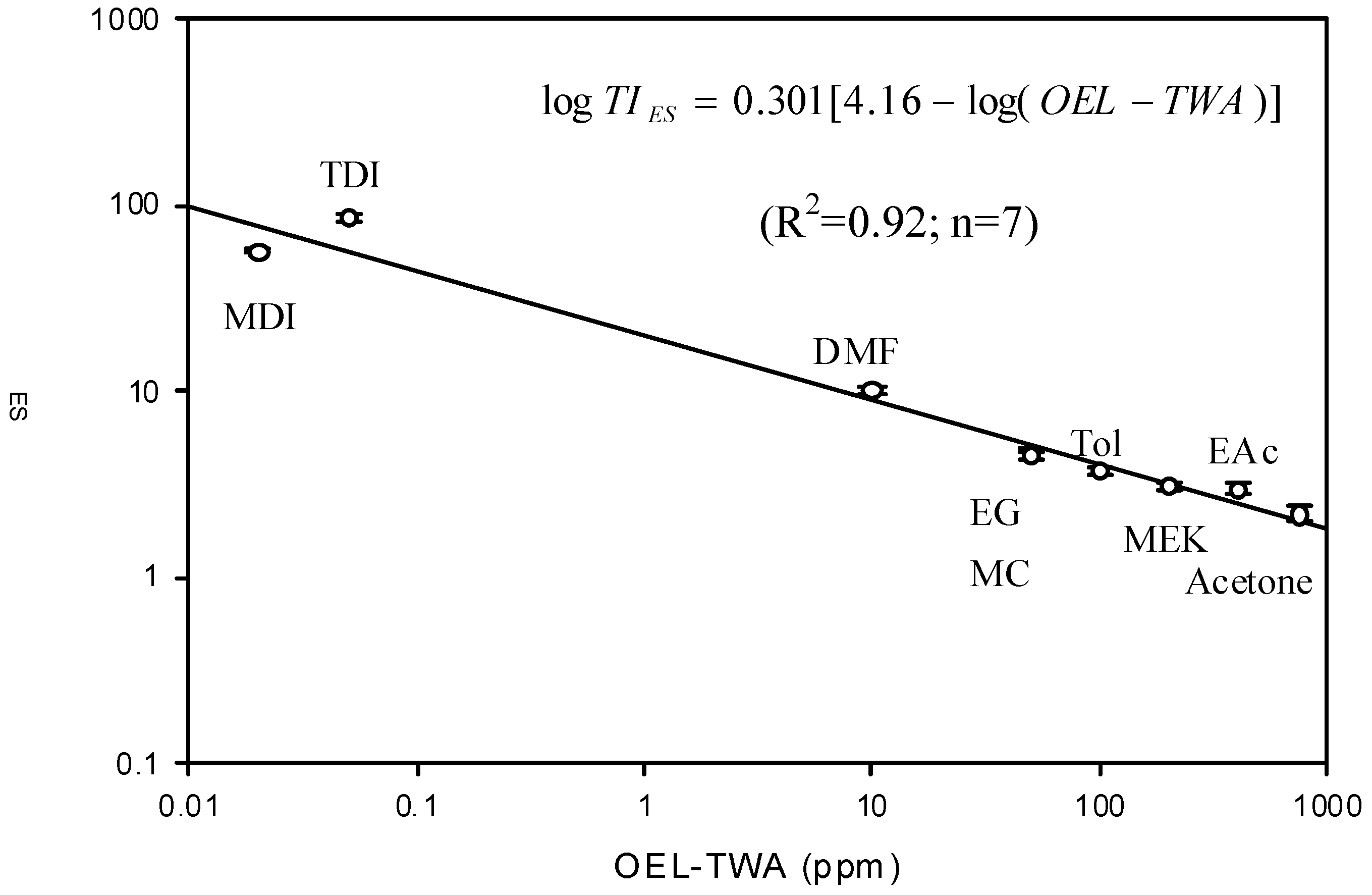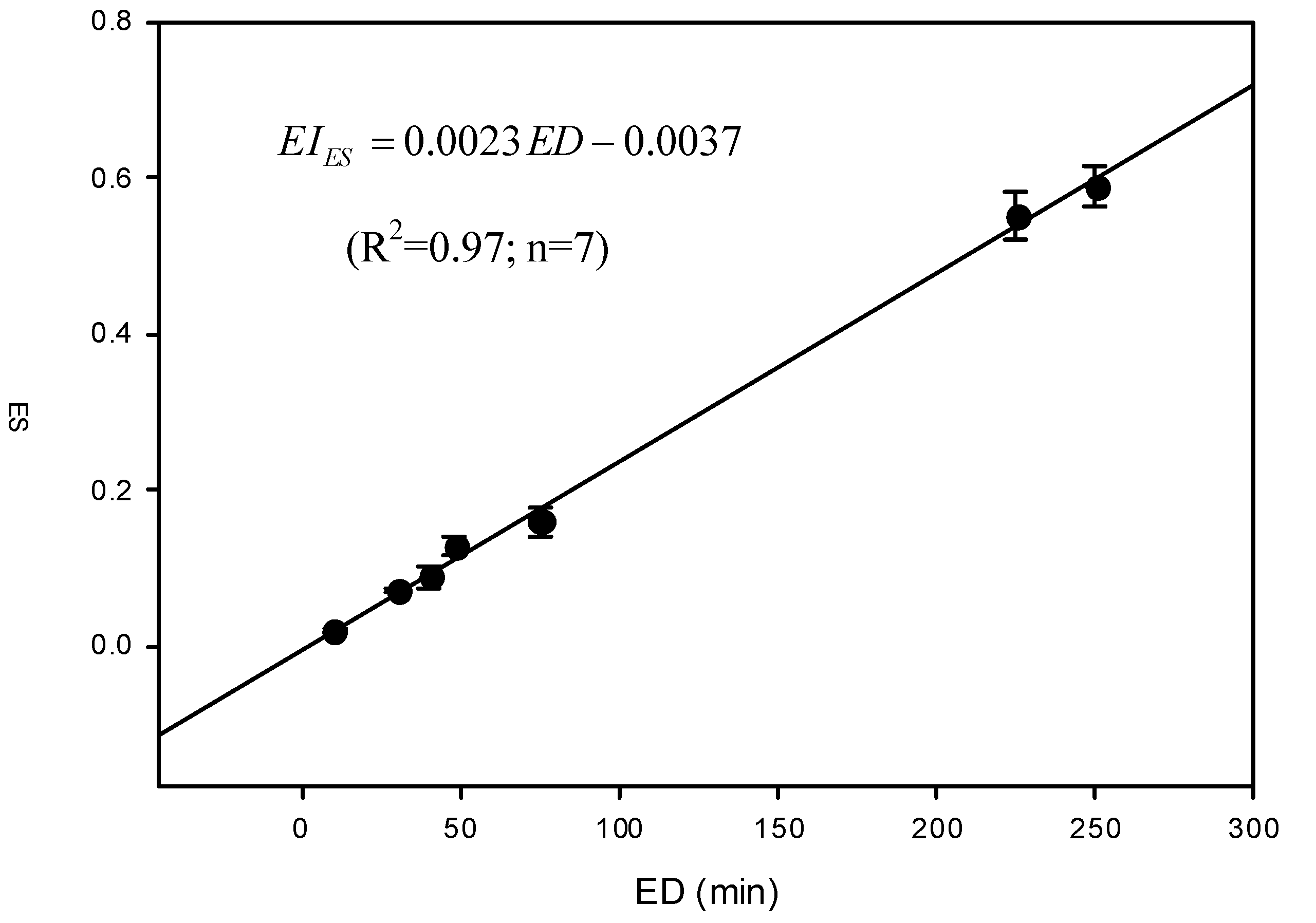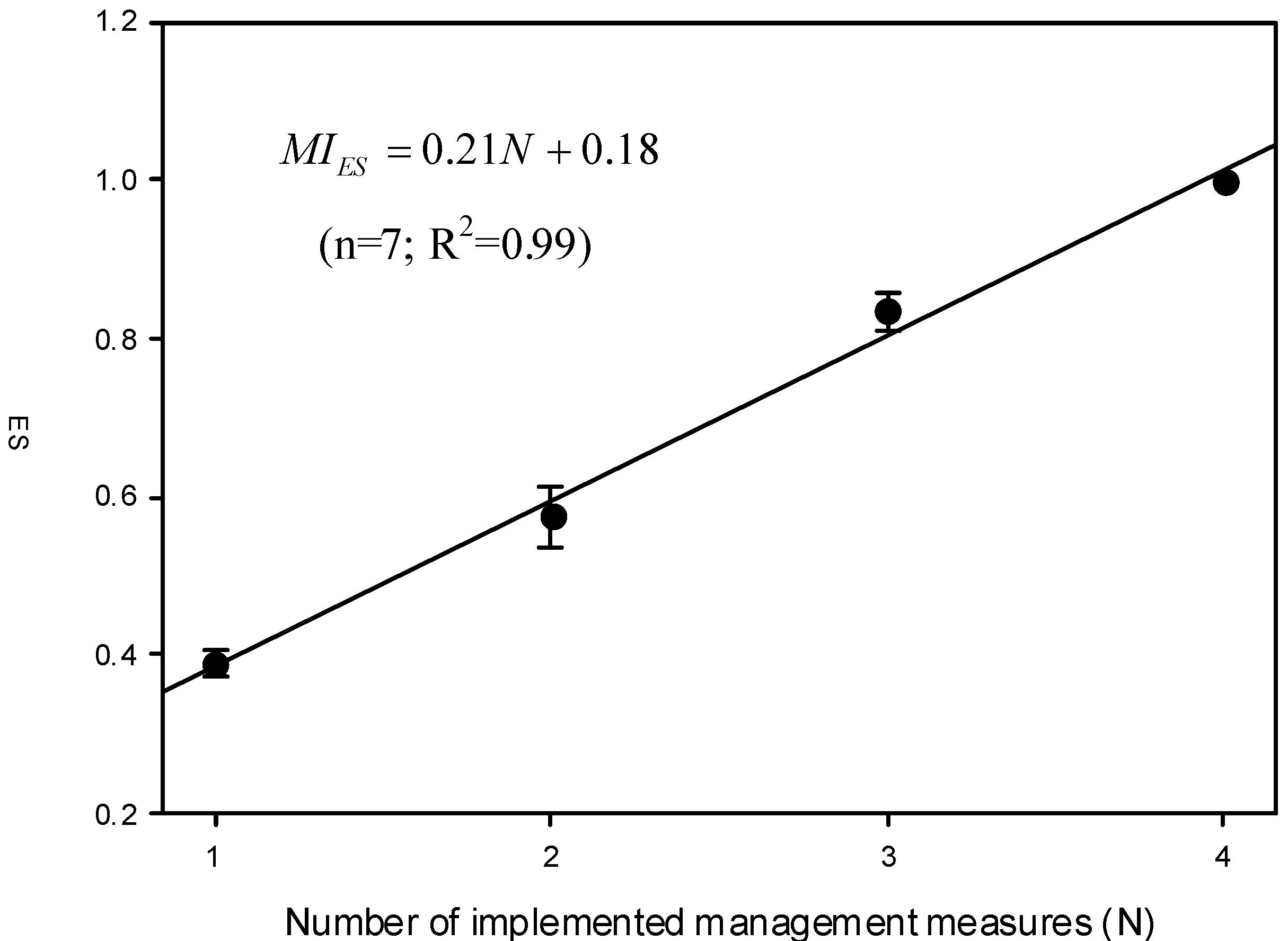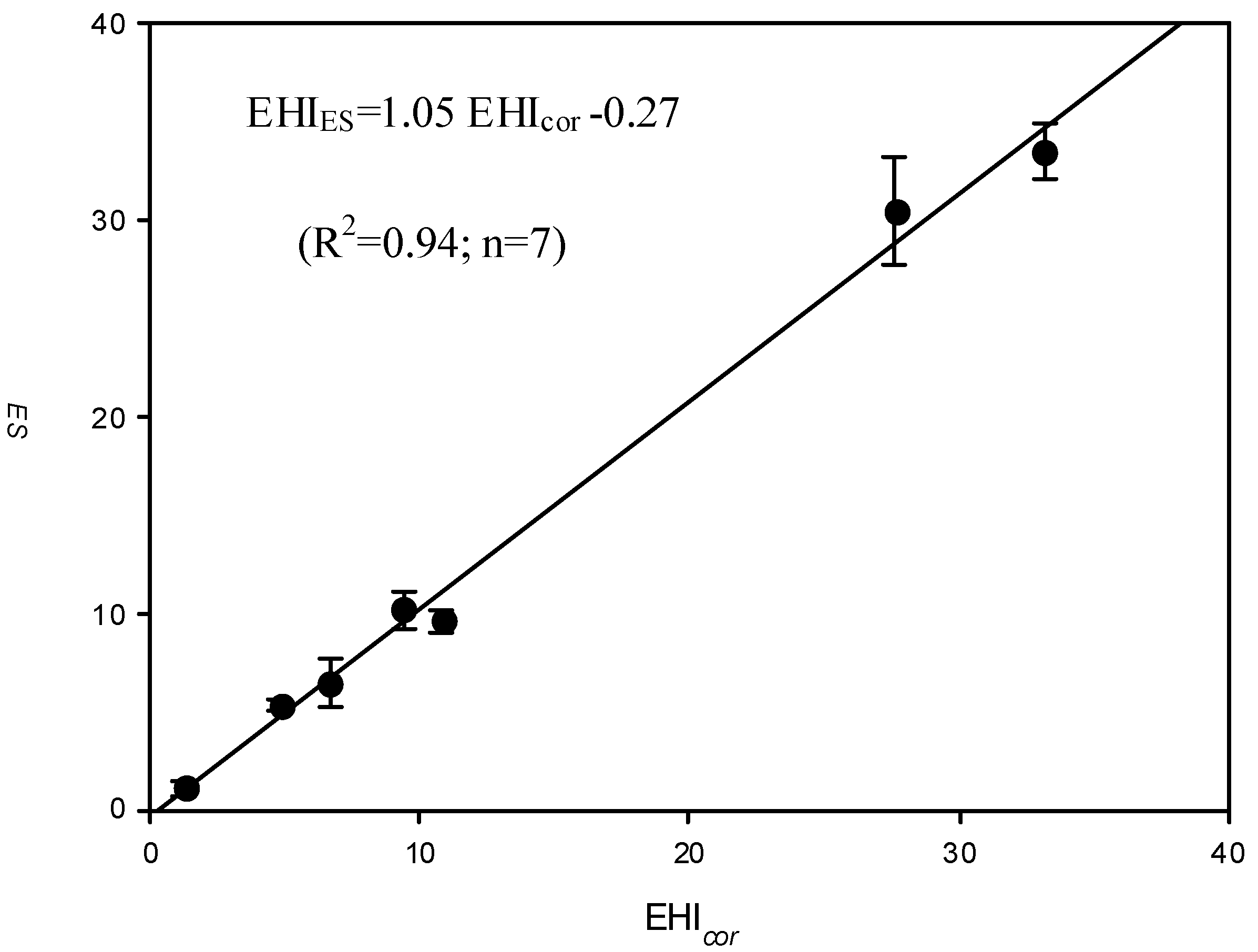Developing a Semi-Quantitative Occupational Risk Prediction Model for Chemical Exposures and Its Application to a National Chemical Exposure Databank
Abstract
:1. Introduction
2. Material and Methods
2.1. Developing a Chemical Exposure Risk Predicting Model

2.1.1. Proposed Toxicity Index (TI)
| Index | Rating |
|---|---|
| TI (rated based on OEL-TWA) | |
| OEL-TWA > 1,000 ppm | 1 |
| 1,000 ppm ≥ OEL-TWA > 100 ppm | 2 |
| 100 ppm ≥ OEL-TWA > 10 ppm | 4 |
| 10 ppm ≥ OEL-TWA > 1 ppm | 8 |
| 1 ppm ≥ OEL-TWA > 0.1 ppm | 16 |
| 0.1 ppm ≥ OEL-TWA > 0.01 ppm | 32 |
| 0.01 ppm ≥ OEL-TWA > 0.001 ppm | 64 |
| 0.001 ppm ≥ OEL-TWA | 128 |
| EI (rated based on exposure duration; ED) | |
| ED < 2 h | 0.30 |
| 2 ≤ ED < 4 h | 0.60 |
| ED ≥ 4 h | 1.00 |
| MI (rated based on the number of implemented management measures; N) | |
| N = 0 | 0.00 |
| N = 1 | 0.25 |
| N = 2 | 0.50 |
| N = 3 | 0.75 |
| N = 4 | 1.00 |
| PI (rated based on the combination of implemented control measures) | |
| EEn+ PPEn | 0.00 |
| EEn+ PPEe | 0.20 |
| EEp+ PPEn | 0.30 |
| EEp+ PPEe | 0.50 |
| EEe+ PPEn | 0.80 |
| EEe+ PPEe | 1.00 |
2.1.2. Proposed Exposure Index (EI)
2.1.3. Proposed Protection Deficiency Index (PDI)

2.2. Correcting the Developed Exposure Hazard Index (EHI)
| Survey results obtained from the 7 selected enterprises | Ratings of indices | ||
|---|---|---|---|
| Compounds and their OEL-TWAs | TIori | TIES | TIcor |
| Toluene diisocyanate, TDI (0.005 ppm) | 64.00 | 86.31 ± 6.28 | 88.10 |
| Methylene bisphenyl isocyanate, MDI (0.02 ppm) | 32.00 | 56.71 ± 4.34 | 58.04 |
| N, N-Dimethylformamide, DMF (10 ppm) | 8.00 | 10.23 ± 1.03 | 8.94 |
| Ethylene glycol, EG (50 ppm) | 4.00 | 4.52 ± 0.67 | 5.51 |
| Methylene chloride, MC (50 ppm) | 4.00 | 4.52 ± 0.67 | 5.51 |
| Toluene, Tol (100 ppm) | 4.00 | 3.86 ± 0.37 | 4.47 |
| Methyl ethyl ketone, MEK (200 ppm) | 2.00 | 3.09 ± 0.42 | 3.63 |
| Ethyl acetate, EAc (400 ppm) | 2.00 | 2.91 ± 0.42 | 2.94 |
| Acetone (750 ppm) | 2.00 | 2.30 ± 0.36 | 2.44 |
| Workers’ exposure durations (EDs) | EIori | EIES | EIcor |
| 10 min | 0.30 | 0.02 ± 0.01 | 0.02 |
| 30 min | 0.30 | 0.07 ± 0.02 | 0.07 |
| 40 min | 0.30 | 0.09 ± 0.05 | 0.10 |
| 48 min | 0.30 | 0.12 ± 0.05 | 0.11 |
| 75 min | 0.30 | 0.14 ± 0.08 | 0.18 |
| 225 min | 0.60 | 0.53 ± 0.11 | 0.52 |
| 250 min | 1.00 | 0.60 ± 0.13 | 0.58 |
| Survey results obtained from the 7 selected enterprises | Ratings of indices | ||
| Numbers of implemented management measures (N) | MIori | MIES | MIcor |
| 0 | 0.00 | 0.00 ± 0.00 | 0.18 |
| 1 | 0.25 | 0.38 ± 0.36 | 0.39 |
| 2 | 0.50 | 0.59 ± 0.06 | 0.60 |
| 3 | 0.75 | 0.82 ± 0.06 | 0.81 |
| 4 | 1.00 | 1.00 ± 0.00 | 1.00 |
| The combination of implemented control measures | PIori | PIES | PIcor |
| EEn + PPEn | 0.00 | 0.00 ± 0.00 | 0.00 |
| EEn + PPEe | 0.20 | 0.18 ± 0.06 | 0.18 |
| EEp + PPEn | 0.30 | 0.42 ± 0.03 | 0.42 |
| EEp + PPEe | 0.50 | 0.61 ± 0.12 | 0.61 |
| EEe + PPEn | 0.80 | 0.74 ± 0.04 | 0.74 |
| EEe + PPEe | 1.00 | 1.00 ± 0.00 | 1.00 |
2.3. Application to a National Chemical Hazard Survey Databank
3. Results and Discussion
3.1. Correcting the Proposed TI




3.2. Correcting the Proposed EI


3.3. Correcting the Proposed PDI


3.4. Comparing the Expert System Proposed EHI (EHIES) with the Corrected EHI (EHIcor)

3.5. Implication of the Corrected EHI Model to a Nationwide Chemical Hazard Survey Database
| Control priority | Recommended industries | EHIcor * |
|---|---|---|
| First priority industries (EHIcor ranking ≥ 90th percentile; EHIcor ≥ 32.43) | ||
| Plastic products manufacturing (n = 37) | 43.47 | |
| Petroleum products manufacturing (n = 7) | 35.54 | |
| Metal products manufacturing (n = 137) | 33.17 | |
| Second priority industries (90th percentile > EHIcor ranking ≥ 70th percentile; 32.43 > EHIcor ≥ 20.61) | ||
| Transportation manufacturing (n = 17) | 31.32 | |
| Electrical equipment manufacturing (n = 22) | 27.23 | |
| Electronic components manufacturing (n = 34) | 23.46 | |
| Chemical materials manufacturing (n = 94) | 21.66 | |
| Paper products manufacturing (n = 17) | 21.44 | |
| Third priority industries (70th percentile > EHIcor ranking ≥ 50th percentile; 20.61 > EHIcor ≥ 10.41) | ||
| Metalworking manufacturing (n = 49) | 17.29 | |
| Chemical products manufacturing (n = 16) | 14.06 | |
| Non-metallic mineral products manufacturing (n = 15) | 12.58 | |
| Leather products manufacturing (n = 9) | 12.03 | |
| Electronic products manufacturing (n = 30) | 10.41 | |
| Fourth priority industries (EHIcor ranking< 50th percentile; EHIcor< 10.41) | ||
| Wood products manufacturing (n = 5) | 10.16 | |
| Printing and data storage products manufacturing (n = 20) | 9.41 | |
| Drug manufacturing (n = 5) | 8.94 | |
| Textile industrial (n = 15) | 8.21 | |
| Foods manufacturing (n = 50) | 7.54 | |
| Machinery and equipment manufacturing (n = 74) | 5.71 | |
| Furniture manufacturing (n = 10) | 5.10 | |
| Automotive manufacturing (n = 17) | 2.48 | |
| Fourth priority industries (EHIcor ranking< 50th percentile; EHIcor< 10.41) | ||
| Machinery and equipment maintenance industry (n = 3) | 2.28 | |
| Rubber products manufacturing (n = 13) | 1.33 | |
| Beverage manufacturing (n = 3) | 1.22 | |
| Clothing products manufacturing (n = 3) | 0.82 | |

4. Conclusions
Acknowledgements
Conflict of Interest
References
- Marchant, G.; Bullock, C.; Carter, C.; Connelly, R.; Crane, A.; Fayerweather, W.; Johnson, K. Applications and findings of an occupational exposure database for synthetic vitreous fibers. J. Occup. Environ. Hyg. 2009, 6, 143–150. [Google Scholar] [CrossRef]
- Kauffer, E.; Vincent, R. Occupational exposure to mineral fibers: Analysis of results stored on colchic database. Ann. Occup. Hyg. 2007, 51, 131–142. [Google Scholar] [CrossRef]
- Yassin, A.; Yebesi, F.; Tingle, R. Occupational exposure to crystalline silica dust in the United States, 1988–2003. Environ. Health Perspect. 2005, 113, 255–260. [Google Scholar] [CrossRef]
- Marchant, G.; Amen, M.; Bullock, C.; Carter, C.; Johnson, K.; Reynolds, J.; Connelly, F.; Crane, A. A synthetic vitreous fiber (SVF) occupational exposure database: Implementing the SVF health and safety partnership program. Appl. Occup. Environ. Hyg. 2002, 17, 276–285. [Google Scholar] [CrossRef]
- National Institute for Occupational Safety and Health (NIOSH), Qualitative Risk Characterization and Management of Occupational Hazards: Control Banding (CB)—A Literature Review and Critical Analysis; US Department of Health and Human services/National Institute for Occupational Safety and Health: Cincinnati, OH, USA, 2009.
- Zalk, D.M.; Nelson, D.I. History and Evolution of control banding: A review. J. Occup. Environ. Hyg. 2008, 5, 330–346. [Google Scholar] [CrossRef]
- Money, C.D. European experiences in the development of approaches for the successful control of workplace health risks. Ann. Occup. Hyg. 2003, 47, 533–540. [Google Scholar] [CrossRef]
- Russell, R.M.; Maidment, S.C.; Brooke, I.; Topping, M.D. An introduction to a UK scheme to help small firms control health risks from chemicals. Ann. Occup. Hyg. 1998, 42, 367–376. [Google Scholar]
- Oldershaw, P. Control banding—A practical approach to judging control methods for chemicals. J. Prev. Med. 2001, 9, 52–58. [Google Scholar]
- Jackson, H. Control banding—Practical tools for controlling exposure to chemicals. Asian-Pac. Newsl. 2002, 9, 62–63. [Google Scholar]
- Health and Safety Executive (HSE), The Technical Basis for COSHH Essentials: Easy Steps to Control Chemicals; Health and Safety Executive (HSE): London, UK, 1999.
- Health and Safety Executive (HSE), COSHH Essentials: Easy Steps to Control Chemicals—Control of Substances Hazardous to Health Regulations HSG193, 2nd ed.Health and Safety Executive (HSE): London, UK, 2003.
- International Labour Organization (ILO), Draft ILO International Chemical Control Kit; International Labour Organization: Geneva, Switzerland, 2006.
- Balsat, A.; de Graeve, J.; Mairiaux, P. A structured strategy for assessing chemical risks, suitable for small- and medium-sized enterprises. Ann. Occup. Hyg. 2003, 47, 549–556. [Google Scholar] [CrossRef]
- Money, C.; Bailey, S.; Smith, M.; Hay, A.; Hudspith, B.; Tolley, D.; Dobbie, J.; Jackson, H. Evaluation of the utility and reliability of COSHH essentials. Letter to the Editor. Ann. Occup. Hyg. 2006, 50, 642–643. [Google Scholar] [CrossRef]
- Paik, S.Y.; Zalk, D.M.; Swuste, P. Application of a pilot control banding tool for risk level assessment and control of nanoparticle exposure. Ann. Occup. Hyg. 2008, 52, 419–428. [Google Scholar] [CrossRef]
- Robichaud, C.O.; Tanzil, D.; Weilenmann, U.; Wiesner, M.R. Relative risk analysis of several manufactured nanomaterials: An insurance industry context. Environ. Sci. Technol. 2005, 39, 8985–8994. [Google Scholar] [CrossRef]
- Maidment, S.C. Occupational Hygiene considerations in the development of a structured approach to select chemical control strategies. Ann. Occup. Hyg. 1998, 42, 391–400. [Google Scholar]
- Hashimoto, H.; Goto, T.; Nakachi, N.; Suzuki, H.; Takebayashi, T.; Kajiki, S.; Mori, K. Evaluation of the control banding method—Comparison with measurement-based comprehensive risk assessment. J. Occup. Health 2007, 49, 482–492. [Google Scholar] [CrossRef]
- Jones, R.M.; Nicas, M. Margins of safety provided by COSHH Essentials and the ILO Chemical Control Toolkit. Ann. Occup. Hyg. 2006, 50, 149–156. [Google Scholar] [CrossRef]
- Tischer, M.; Bredendiek-Kämper, R.; Poppek, U. Evaluation of the HSE COSHH Essentials exposure predictive model on the basis of BAuA field studies and existing substances exposure data. Ann. Occup. Hyg. 2003, 47, 557–569. [Google Scholar] [CrossRef]
- Finny, D.J. Quantal Responses and the Dose-response Curve. In Probit Analysis; Cambridge University Press: New York, NY, USA, 1971; Chapter 2; pp. 8–19. [Google Scholar]
- Finny, D.J. Estimation of the Median Effective Dose-response Curve. In Probit Analysis; Cambridge University Press: New York ,NY, USA, 1971; Chapter 3; pp. 20–48. [Google Scholar]
- Tait, K. The workplace exposure assessment expert system (WORKSPERT). Am. Ind. Hyg. Assoc. J. 1992, 53, 84–98. [Google Scholar] [CrossRef]
- Fritschi, L.; Nadon, L.; Benke, G.; Lakhani, R.; Latreille, B.; Parent, M.E.; Siemiatycki, J. Validation of expert assessment of occupational exposures. Am. J. Ind. Med. 2003, 43, 519–522. [Google Scholar] [CrossRef]
© 2013 by the authors; licensee MDPI, Basel, Switzerland. This article is an open access article distributed under the terms and conditions of the Creative Commons Attribution license (http://creativecommons.org/licenses/by/3.0/).
Share and Cite
Wang, S.-M.; Wu, T.-N.; Juang, Y.-J.; Dai, Y.-T.; Tsai, P.-J.; Chen, C.-Y. Developing a Semi-Quantitative Occupational Risk Prediction Model for Chemical Exposures and Its Application to a National Chemical Exposure Databank. Int. J. Environ. Res. Public Health 2013, 10, 3157-3171. https://doi.org/10.3390/ijerph10083157
Wang S-M, Wu T-N, Juang Y-J, Dai Y-T, Tsai P-J, Chen C-Y. Developing a Semi-Quantitative Occupational Risk Prediction Model for Chemical Exposures and Its Application to a National Chemical Exposure Databank. International Journal of Environmental Research and Public Health. 2013; 10(8):3157-3171. https://doi.org/10.3390/ijerph10083157
Chicago/Turabian StyleWang, Shih-Min, Trong-Neng Wu, Yow-Jer Juang, Yu-Tung Dai, Perng-Jy Tsai, and Chiu-Ying Chen. 2013. "Developing a Semi-Quantitative Occupational Risk Prediction Model for Chemical Exposures and Its Application to a National Chemical Exposure Databank" International Journal of Environmental Research and Public Health 10, no. 8: 3157-3171. https://doi.org/10.3390/ijerph10083157




